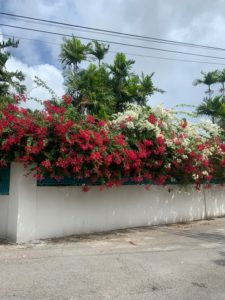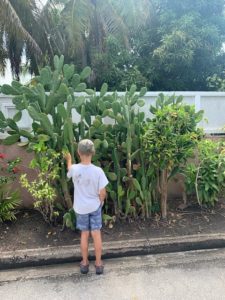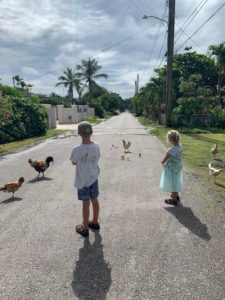First Walk -Version 2.0
Before completing this blog, I re-read my post on my first walk in Honduras. In between postings, we spent three years walking and biking around our neighbourhood in Gatineau, Quebec (COVID restrictions notwithstanding.) In Canada, there were no armed guards or tall security walls. Our house was at the far end of a cul-de-sac and the children roamed free; our eldest son learnt scooter tricks from the neighbours and picked up new street hockey skills. Skip ahead to Barbados where there are no longer red zones or security maps to consider. It is sunny all year round and we can see azure blue sea beaconing from the second floor of our house. On this Caribbean triangular shaped island in the middle of the sea, the closest beach on Google maps appeared to be less than 1 km away; we figured roughly 10 minutes walk straight down the hill. We were eager to go out exploring; to take our first walk -version 2.0.
First Walk
Having unpacked our suitcases and settled in, we opted to leave the house early in the morning to avoid the scorching midday sun. We lathered on thick sunscreen and everyone was instructed to wear a hat. We made sure to pack our swimsuits, towels, and two big bottles of cold water. Destination: the beach!
Let me describe what we saw on our first walk after we left the gates at the end of our driveway: lots of cars close up, colourful flower and fauna strewn with litter, along with a glimpse of an exotic animal or two. The main road at the end of our drive is quite busy. There are no sidewalks but a sizeable grassy embankment provides us a narrow buffer from the passing cars. Holding hands, we venture gingerly onto the road constantly reminding each other to look out for cars on the left hand side. (I still catch myself looking the wrong way. My instinct being hard wired to look left, then right then left again. More on my driving adventures in an upcoming post.) Meanwhile, the small cars, white taxi vans, and large tour buses shuttering tourists pass us by at impressive speed, grazing our shoulders in the process. In the game of chicken – we always end up jumping out of the way and onto the grass each time a car passes by.

Neighbours
Our neighbours three doors down own a pair of huge dogs who do a great job of growling and generally guarding the place. Funnily, they don’t lunge at us even when the gates are open; their enormous stature and bark is menacing enough. The next house on the corner appears to be abandoned. There are mature trees seemingly growing out of the windows and roof of the derelict building. Prickly cactus plants on the grounds also keep marauders at bay. The steps from the road up to the front door are so overgrown that I don’t notice them until the children point them out to me:
-Who lives there mama?
-I don’t think anyone does my dear.
-Maybe it’s a house for the monkeys.
The crashing waves and the beach beacon, so we venture a little further down the road and descend the small hill round the corner, we see the ocean in the distance and smell the salty air. We speed walk this section on alert, passing chain link fences and stump brick walls. There is no sidewalk and the narrow embankment is littered with garbage and uneven paving stones. Plastic bottles, takeout containers and litter cover the ground between the shrubs and trees.

Coastal Road
Next we get to the road I affectionately call the “Coastal Road.” This two lane road strewn with potholes is the thoroughfare that both locals and tourists use to go from one beach to the other on the island. The coastal road follows the curve of the coastline as it runs from the airport to the capital Bridgetown. At the intersection, we are accosted by an eager bus driver who slows down and gestures out the window calling out: “Beach? Bridgetown? Shops?” A polite smile and “No, thank you!” is enough for the private taxi-bus driver to continue on his way. We prepare to cross the busy street and frantically look both ways (right, left, right; or am I still wrong?) Soon enough, the drivers of the vehicles in both directions slow to a stop and flash their lights twice signalling that it is safe for us to walk across.
Once past this busy stretch of “highway” we collectively let out a sigh of relief. The next neighbourhood is not so busy. The front lawns are greener and cleaner. Tall palm trees wave us along and provide some shade. We start to take in more details in our surrounding: vibrant orange, pink, purple and white bougainvillea bushes.Red pomegranates hanging tantalizingly from a tree. Sweet smelling yellow and white frangipani flowers tickle our nostrils. Plump green papayas push their way towards the sun. It appears that common house plants have exploded into huge versions of themselves as they flourish here in their natural habitat. My youngest spots a flash of white jumping from the bushes into a tree. Probably a green monkey eating ripe guavas. The green monkeys seem to be as common as squirrels back home.

Chicken House
Eventually, we come to the house which we have affectionately started to call the “Chicken House” where mother hens corral their chicks who peck at everything underfoot: from rocks, to flowers, to garbage. They will taste everything looking for edible food. We happily stop for a while and watch these free range birds. We laugh as they “cock-a-doodle-doo.” Several roosters parade their colourful feathers as they strut between the driveway and the grassy abandoned field:
-Who is still asleep at 3pm in the afternoon? the kids wonder.
-Don’t get too close to the chickens or they will start running after you, warns papa.
-Maybe they think we are going to feed them.
-Why did the chicken cross the road? So he could go to Chefette!! (the local version of McDonalds) jokes our 5 year old.
I’m not quite sure she has made the connection between the chickens and where her chicken nuggets come from. (Or maybe she does and has a very dark sense of humour.) Later at dusk, we watch the chickens stealthily climb up the frangipani trees to safely roost overnight.

Final Stretch
The last landmark before the beach is the green playing field. It is sometimes used as a soccer pitch but more often we see boys dressed all in white playing cricket under the glaring hot sun. This harps back to colonial days and British influence in Barbados. Locals are very proud of the sport. Our British Grandpa tried to give us a primer before we left Canada: “It’s a bit like baseball but with two bats.”
And now we are at Dover beach, we find a shady spot under a palm tree, lay down our things and race each other to frolic in the gentle salty waves for our “sea bath.”
Compared to Honduras, we can freely walk everywhere. Compared to Canada, the heat is at times limiting and the very narrow uneven roads without sidewalks make it somewhat dangerous for biped pedestrians. Each trip down to the beach is a challenge, but we are rewarded by the sound of the crashing waves, the salty smell in the air, the fine sand underfoot and the gentle sea waves that rock away the days’ troubles.

Does the chicken know that he is on Chefette’s menu? He might want to stay on this side of the road!!!
The sound of the waves is indeed a reward, no matter how challenging your walk, your day or your week. Makes Barbados a lovely place to live!!
I loved reading your comparison of a walk in 3 different countries! 🥰